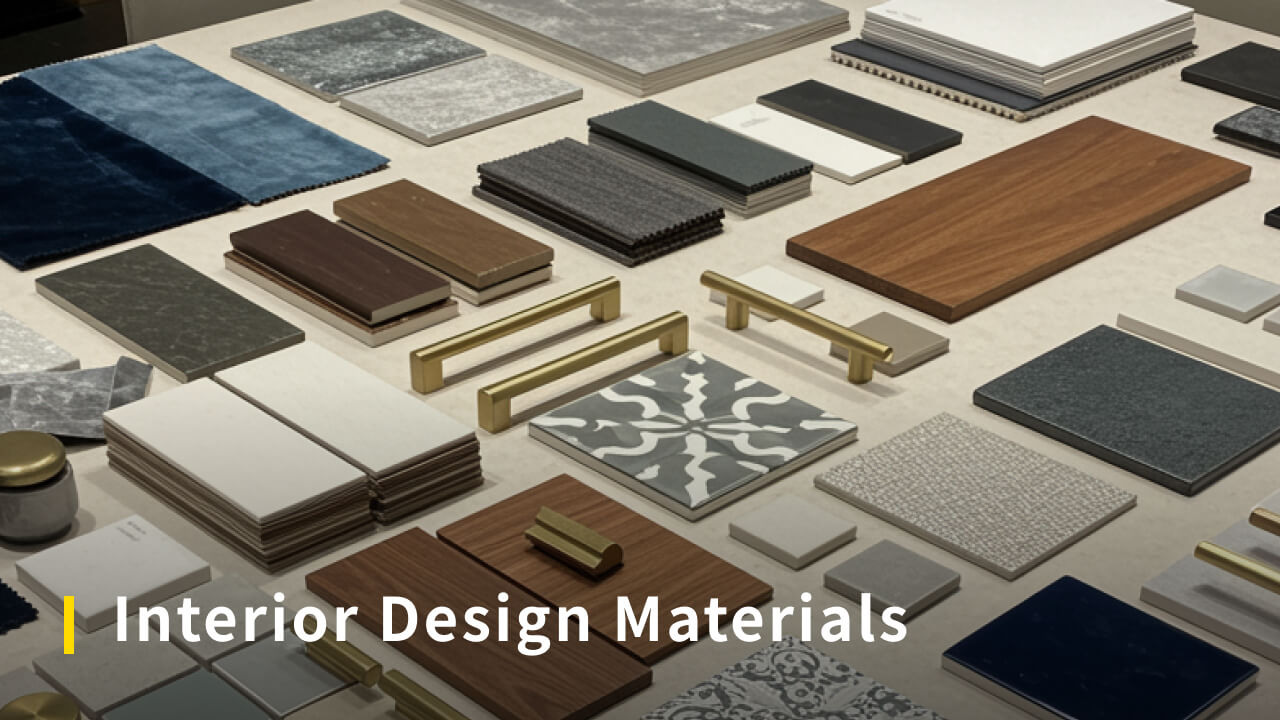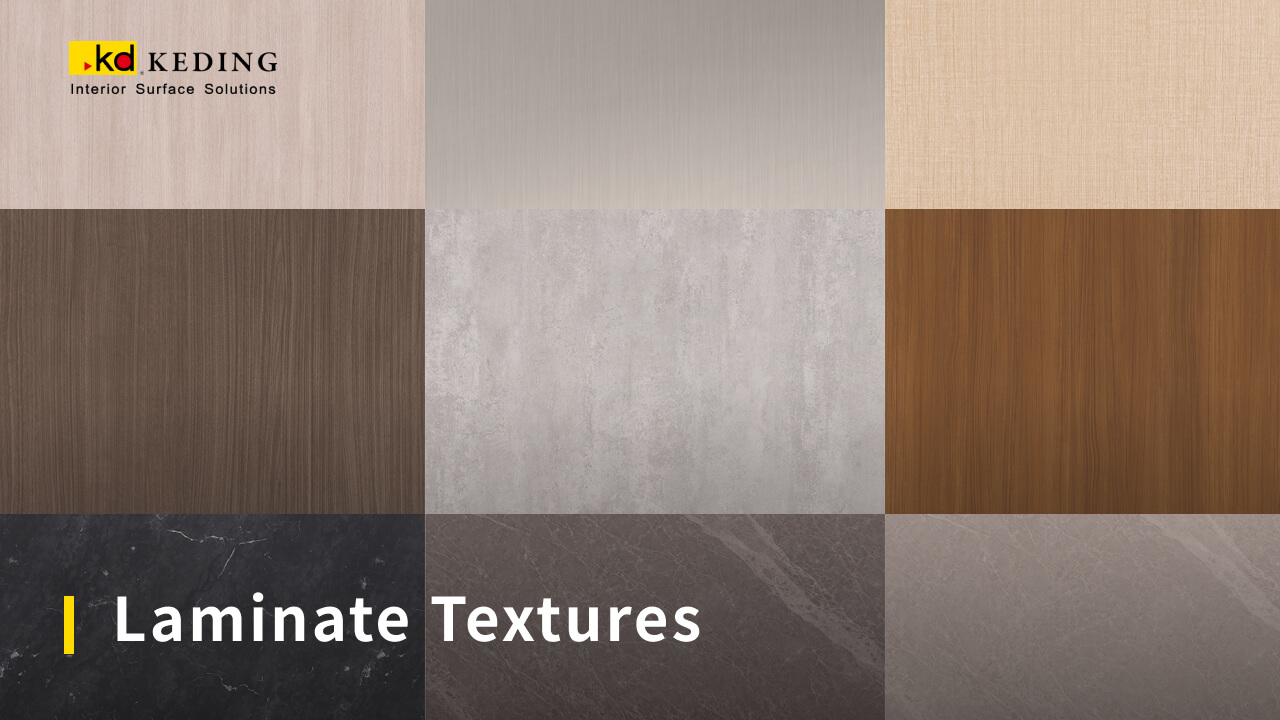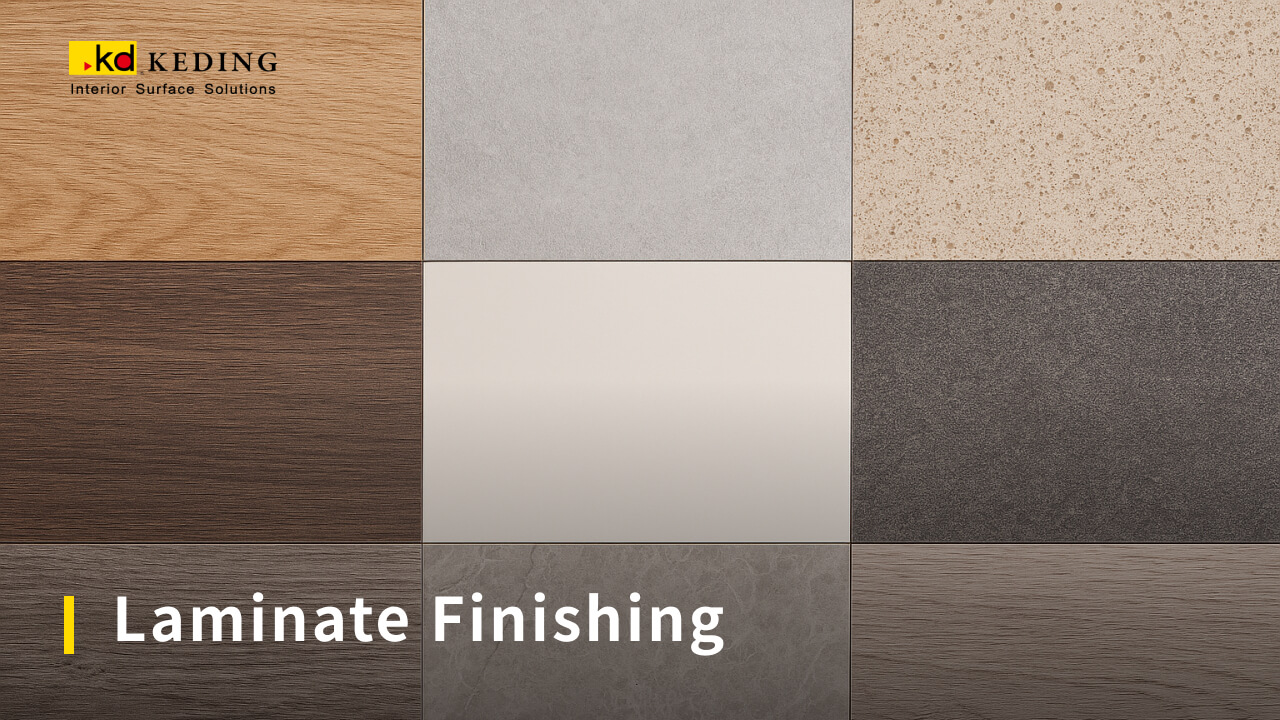Selecting the right home interior materials can feel overwhelming with many options. Pick the wrong one, and you might end up with a mismatched design, durability issues, or unexpected costs. But don’t worry—this guide will walk you through the different types of materials used in interior design, breaking down their looks, strength, and cost so you can make the perfect choice for your space! Let’s go!
What are the Interior Design Materials?
Interior design materials are the building blocks that shape the look and feel of your home. From the warmth of wood floors to the sleekness of glass tabletops, these materials define each room’s character. They include natural elements like stone and fabrics, as well as man-made options like metals and synthetics. Common applications include using wood for flooring and furniture, glass for windows and partitions, and fabrics for upholstery and drapery.
Selecting the right materials is crucial in interior design as they define both the functionality and aesthetics of a space. In the next section, we will explore some common materials and their typical uses, along with their advantages and disadvantages.
Common Types of Materials and Finishes in Interior Design
Interior design brings together a variety of materials and finishes, each chosen to create different styles, textures, and atmospheres. These materials fall into four main categories: natural, synthetic, composite, and other—each offering its own unique charm and benefits. Understanding these differences helps you find the perfect match for your style, durability needs, and budget. Ready to explore how these materials can transform your space? Let’s dive in!
Natural Materials
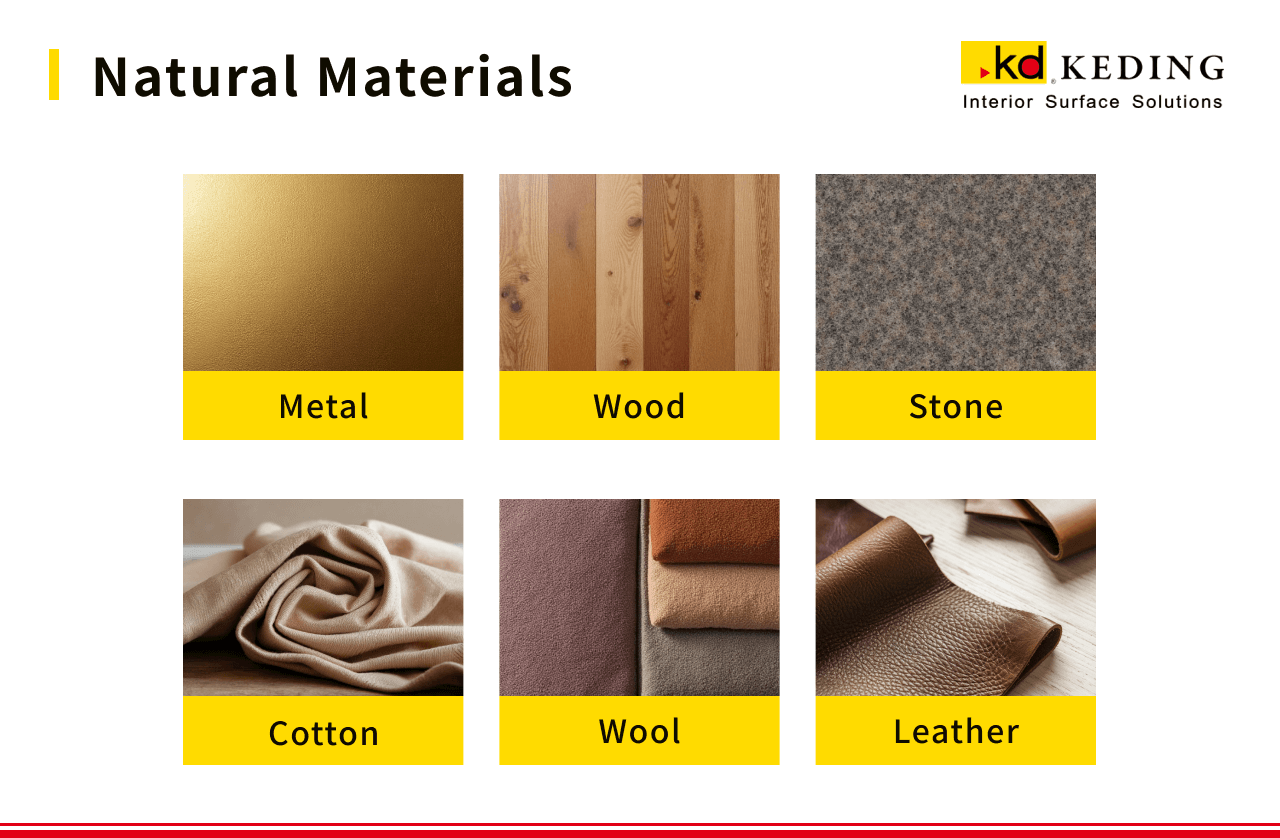
If you want your space to feel warm, organic, and timeless, natural materials are the way to go. These are materials sourced straight from nature—wood, stone, metals, and fabrics that bring a rich, authentic texture to any room. They’re known for their durability, uniqueness, and ability to age beautifully over time. Still, they often require maintenance and can come at a higher price. Here are some of the most popular natural materials and how they can enhance your interior design.
Metal
Metal is a versatile material used in interior design in various forms, including rods, railings, sheets, and pipes.
It fits effortlessly into industrial, rustic, and contemporary styles, adding a sleek or rugged aesthetic, depending on its finish. Metal is incredibly durable and strong, making it a reliable choice for structural and decorative elements. It’s commonly found in support structures, stair railings, furniture frames, and decorative accents in bedrooms and living areas.
Metal elements add a distinct visual appeal, contributing to the modern, edgy, or vintage charm of the space. However, some metals may be prone to rust if not properly treated, and they can sometimes feel cold or impersonal. Despite this, metal remains a go-to material for those looking to create a bold and structured design.
Hardwood (Wood)
A timeless favorite in interior design, hardwood comes in various species, each offering unique colors, textures, and patterns.
Whether it’s oak, maple, teak, or walnut, wood provides a natural warmth that makes spaces feel cozy, sophisticated, and inviting. Its versatility allows it to be used for floor finishings, wall and ceiling fishings, furniture, and decorative accents, making it one of the most adaptable materials available.
Hardwood is also relatively affordable, with different options to fit various budgets. Its natural grain and warmth create a sense of comfort and serenity, making it a top choice for both traditional and modern interiors. Nevertheless, wood requires regular maintenance to protect against moisture, scratches, and wear, especially in high-traffic areas.
Barnwood
For those who love rustic charm and sustainability, barnwood is an excellent material to incorporate into interior design.
Reclaimed from old barns, warehouses, and historical buildings, this wood carries sentimental value and a rich history, making it an authentic and character-filled choice. Barnwood is often found in decorative walls, custom furniture, shelving, and flooring, adding a unique, weathered look that blends well with rustic, farmhouse, or industrial styles. Besides its aesthetic appeal, it is also eco-friendly, reducing the demand for newly harvested lumber.
However, because it is a reclaimed material, it may have imperfections such as knots, cracks, and nail holes, which add to its rustic appeal but may not suit all design preferences. Despite this, its ability to bring warmth, personality, and sustainability to a space makes it a standout choice for natural interior design.
Stone (Marble, Granite, Quartz)
Stone is synonymous with luxury, durability, and natural beauty. Each slab features unique color variations and patterns, making every application one-of-a-kind.
Granite is a top choice for kitchen countertops and backsplashes, as it is heat-resistant and scratch-proof, especially when polished. Marble, with its elegant veining, is perfect for dining tables, side tables, and statement décor, adding a touch of classic sophistication. Quartz, often engineered, offers high durability and minimal maintenance, making it an excellent alternative for countertops and surfaces.
While stone adds timeless elegance and value to interiors, it is heavy, expensive, and may require sealing to prevent staining. Nevertheless, its resilience and visual appeal make it an unmatched material for creating high-end, refined spaces.
Cotton/Linen
Cotton and linen are natural, breathable fabrics known for their softness, sustainability, and eco-friendliness.
These textiles are widely utilized in upholstery, curtains, bedding, and cushions, promoting a light, airy, and organic aesthetic. Cotton is a long-lasting, easy-to-maintain fabric, while linen offers a more relaxed, textured appearance that suits casual and rustic styles. Both fabrics contribute to better indoor air quality, making them an excellent choice for allergy-sensitive homes.
Still, they are prone to wrinkling and may stain easily, requiring occasional special care. Despite this, their timeless appeal and environmentally friendly properties make them a go-to choice for those seeking comfort and sustainability in their interiors.
Wool
A luxurious and cozy natural material, wool is commonly found in rugs, upholstery, blankets, and soft furnishings.
It adds a warm and inviting atmosphere to any space while providing excellent insulation and softness underfoot. Wool’s resilience against dirt and moisture makes it a stable option for homes, though it may require professional cleaning to maintain its condition.
Available in a range of textures and thicknesses, wool can suit modern, rustic, or classic interiors effortlessly. While it can be expensive, its comfort, longevity, and ability to add a plush finishing touch make it well worth the investment.
Leather/Velvet
If you’re looking for luxury, texture, and timeless appeal, leather and velvet are standout choices in interior design.
Leather is known for its durability, ease of maintenance, and ability to develop a rich patina over time, making it perfect for sofas, armchairs, headboards, and ottomans. It fits seamlessly into modern, classic, and industrial styles, adding a sense of refinement.
On the other hand, velvet brings a soft, plush feel, making it ideal for elegant furniture, accent chairs, and drapery. Velvet’s deep color saturation and rich texture create a luxurious and cozy ambiance, though it can be prone to staining and requires gentle care.
Leather, while long-lasting, can feel cold in winter and sticky in summer if not properly treated. Both materials exude sophistication, making them great choices for those who want to add depth and elegance to their interiors.
Synthetic Materials
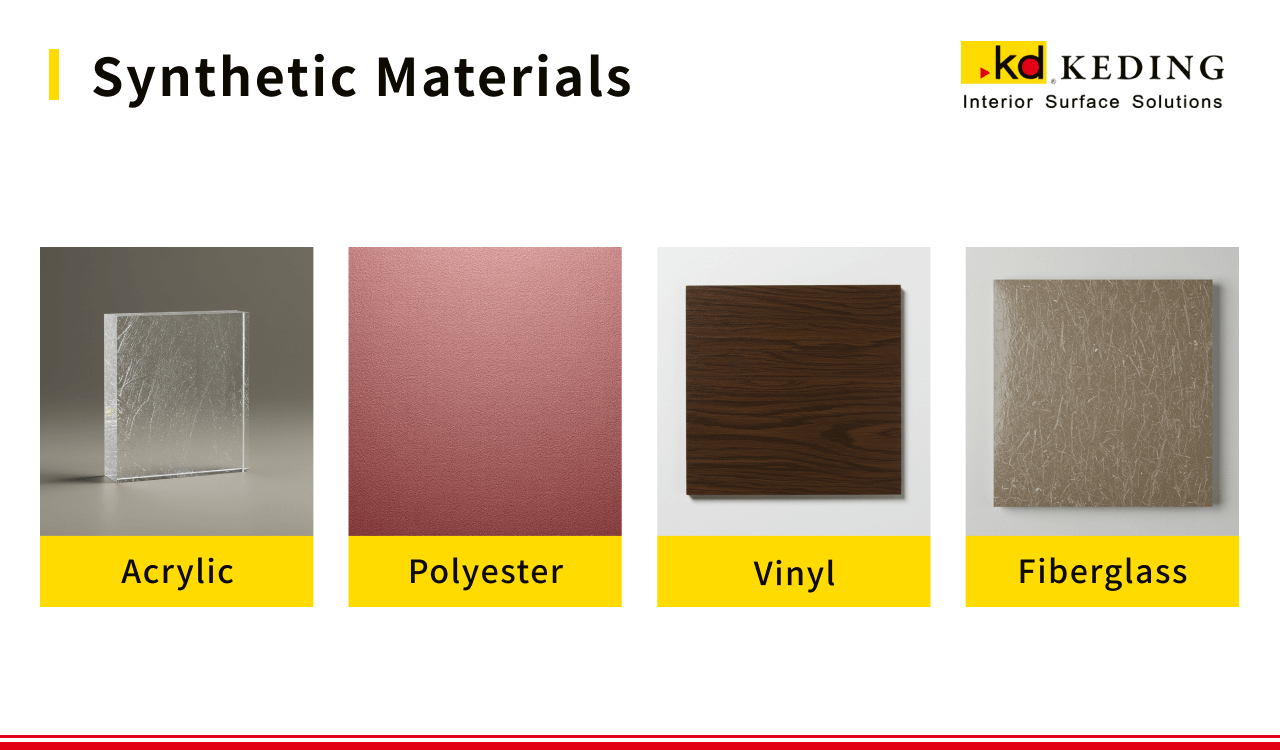
If you’re looking for affordable, versatile, and stylish interior design solutions, synthetic materials are a great option. They can mimic the look of natural materials like wood, stone, and tile, offering a budget-friendly alternative without sacrificing aesthetics. These materials are also durable, low-maintenance, and often moisture-resistant, making them ideal for high-traffic or high-humidity areas.
Plastic
Plastic is an incredibly flexible material in interior design, literally and figuratively. It can be molded into various shapes using heat, making it perfect for creating curved edges and seamless surfaces. This quality makes it a common choice for countertop edges, decorative moldings, and sleek modern furniture.
Plastic is also lightweight and moisture-resistant, making it a practical solution in areas prone to spills or high humidity. While it offers great design flexibility, some plastic finishes may not have the same premium feel as natural materials and can be prone to scratches or discoloration over time.
Acrylic
Acrylic is a sleek, stylish, and highly adaptable material that mimics the appearance of real wood, veneers, or even glass.
Available in a wide range of colors, patterns, and finishes—from matte to high-gloss—it offers endless design possibilities. It is commonly used in modern furniture, cabinetry, wall panels, and decorative elements, bringing a polished and contemporary look to interiors.
Acrylic is also lightweight, shatter-resistant, and easy to maintain, making it a great alternative to glass or natural wood. Even so, while it provides an elegant look, it can be prone to scratching and may not offer the same warmth as real wood.
Polyester
Polyester is an enduring and versatile synthetic fabric in interior design application. Its strength and resistance to stretching and shrinking make it ideal for various applications, including upholstery, curtains, and carpets.
Polyester is also stain-resistant and easy to maintain, making it a practical choice for households with children or pets. However, it is not as breathable as natural fibers, which can impact comfort in certain applications. Polyester is also prone to static buildup and may pill over time, especially in high-friction areas.
Vinyl
Vinyl is a highly durable, water-resistant, and cost-effective material that has become a staple in interior design, especially for flooring and wall coverings. It’s easy to clean, low-maintenance, and can replicate the look of natural materials like wood, stone, or tile at a fraction of the cost. This makes it perfect for bathrooms, kitchens, and high-traffic areas.
Dark-colored vinyl flooring can also complement industrial or modern interiors with its sleek and polished appearance. The downside? While vinyl is practical and stylish, cheaper versions may lack the depth and authenticity of real wood or stone. Still, high-quality vinyl options provide a stunning alternative that’s both long-lasting and aesthetically pleasing.
Fiberglass
Fiberglass is a lightweight yet incredibly strong material that’s widely used in construction but also has applications in interior design. It is highly resistant to moisture, mold, and fire, making it a great option for bathrooms, ceilings, and reinforced wall panels.
Fiberglass is also commonly found in decorative elements like wall claddings and translucent panels, adding a sleek, contemporary touch. One of its biggest advantages is its low-maintenance nature, but it can be brittle under heavy impact and may require professional installation for the best results.
Nanomaterials
Nanomaterials are the cutting-edge future of interior design, offering self-cleaning, antibacterial, and ultra-durable properties. They are engineered at the microscopic level to enhance surface strength, resistance to stains, and even air purification.
While still emerging in mainstream design, nanomaterials are applied in high-performance coatings, ultra-resistant countertops, and smart textiles that adjust to environmental conditions. The downside? They can be expensive and not widely available yet, but they hold immense potential for low-maintenance, high-tech interiors in the near future.
Composite Materials
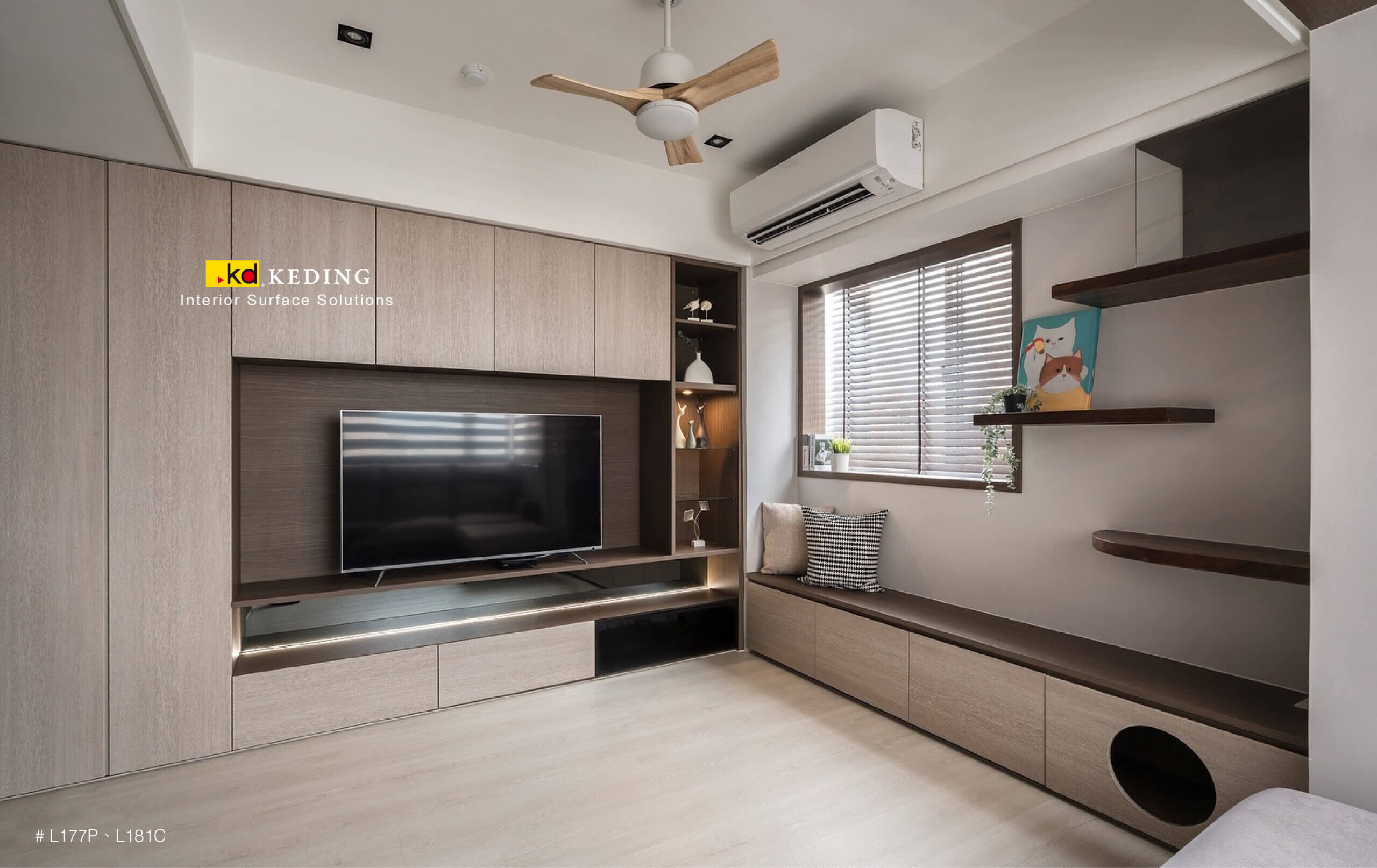
These engineered products combine various wood fibers, particles, or veneers with adhesives to create materials that often outperform traditional solid wood in specific applications. Let’s take a look at some popular composite materials:
Melamine Board
Melamine boards are created by applying a melamine resin—a durable plastic—onto a substrate like particleboard or MDF (Medium-Density Fiberboard). This process results in a hard, strong, and moisture-resistant surface that can mimic the appearance of more expensive materials like wood or stone.
They offer a wide range of colors and textures, are easy to clean, and are more resistant to moisture compared to standard particleboard, making them suitable for humid environments like kitchens and bathrooms. Ideal for cabinetry, shelves, and furniture where a decorative yet firm surface is desired. While melamine surfaces are moisture resistant, the underlying core can be susceptible to water damage if the surface layer is compromised.
Particle Board
Made from wood chips, sawdust, and resin, particleboard is a lightweight and cost-effective material. It’s affordable and easy to work with, making it popular for budget-conscious projects. Commonly found in ready-to-assemble furniture, countertops, and interior components where high strength isn’t critical. Even so, particleboard lacks the strength and durability of other materials like plywood and is prone to damage from moisture, leading to swelling or warping.
Plywood
Constructed from thin layers of wood veneer glued together with the grain of each layer at right angles to the next, enhancing strength and reducing warping. Plywood is strong, versatile, and suitable for both structural and decorative applications. Used in cabinetry, flooring, wall panels, and furniture. Higher-quality plywood can be more expensive, and edges may require finishing to achieve a polished look.
HDF (High-Density Fiberboard)
HDF is made by compressing wood fibers with resin under high pressure, resulting in a dense and smooth surface. It provides a uniform texture, is resistant to warping, and offers a smooth surface ideal for painting or laminating. Often found in high-quality flooring, cabinetry, and door panels. Yet, HDF can be heavy and, like other fiberboards, is susceptible to moisture damage if not properly sealed.
Veneer
A veneer is a thin slice of natural wood glued onto a core material like plywood or MDF, providing the appearance of solid wood. It offers the aesthetic appeal of real wood at a fraction of the cost, is eco-friendly by maximizing the use of precious wood species, and allows for consistent grain patterns. Commonly used in furniture, cabinetry, and wall paneling to achieve a high-end look. However, veneers are thin and can be damaged easily; they may delaminate over time if not properly maintained.
Laminate
Laminate is a versatile material crafted by bonding multiple layers of paper or fabric impregnated with resin under high pressure and heat, resulting in a strong and decorative surface. Its scratch-resistant and easy-to-clean nature makes it ideal for high-traffic areas such as countertops, kitchen cabinetry, and wall panels.
Also, laminate’s availability in a vast array of colors, designs, finishes, and patterns, including designs that mimic natural materials like wood or stone, allows for diverse aesthetic applications. Despite their durability, laminate surfaces can chip or peel over time, and repairing damaged areas can be challenging. Therefore, while laminate offers a cost-effective and stylish solution for various interior design needs, it’s essential to consider these potential drawbacks when selecting materials for your space.
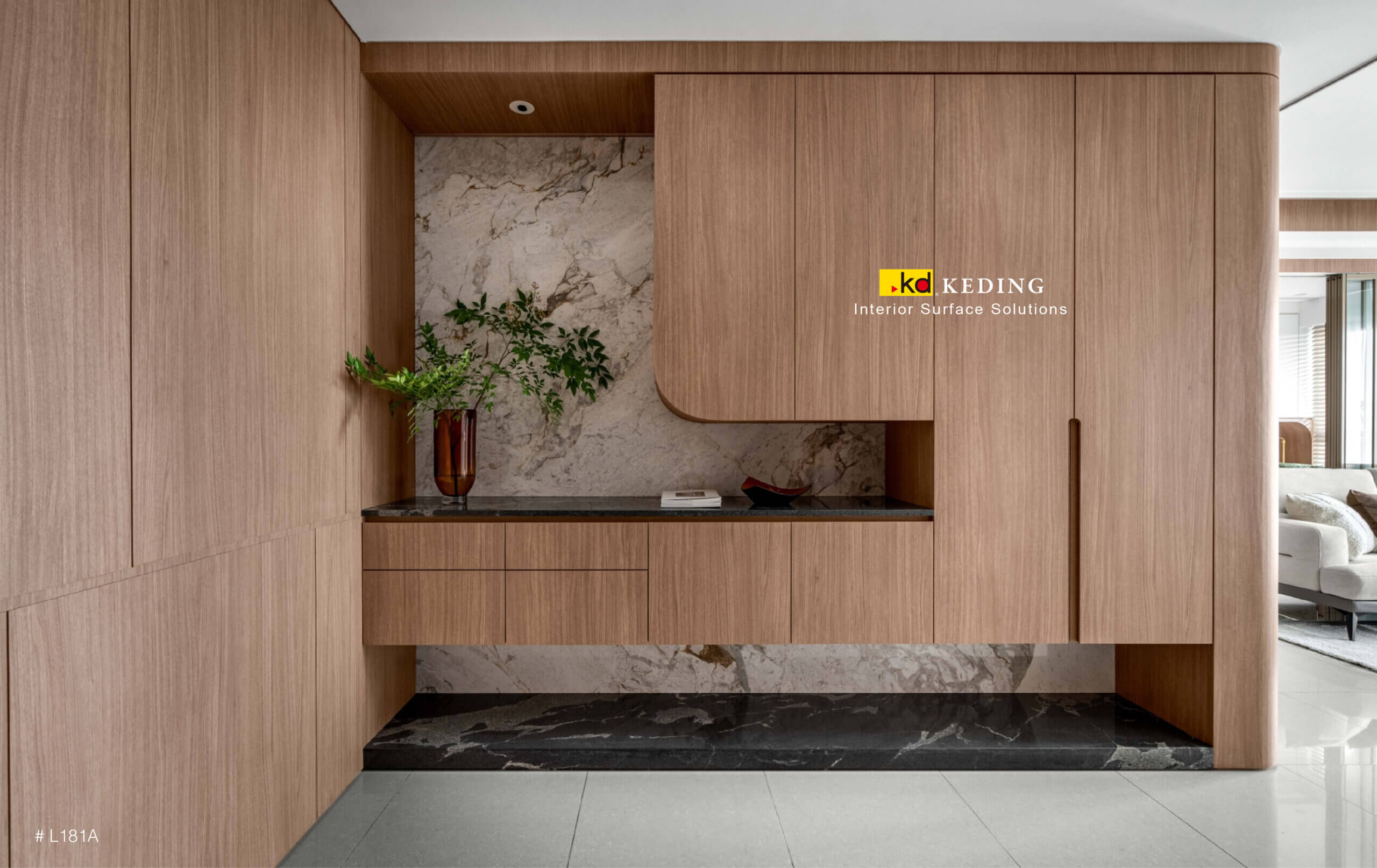
Other Materials
Apart from the above types, there are still many materials commonly used in interior design.
Glass (Colored, Lacquer, Opaque, Recycled)
Glass introduces elegance and sophistication into interior spaces. Colored and lacquered glass, known for its high luster and luxurious feel, is often utilized in bedrooms to enhance visual appeal. They are ideal for wardrobe doors and TV units, adding a sleek and modern touch.
Opaque or frosted glass provides privacy while allowing light to filter through, making it suitable for partitions or bathroom enclosures. Recycled glass is gaining popularity as an eco-friendly option, offering unique textures and colors for countertops or decorative accents. However, glass can be prone to fingerprints and requires regular cleaning to maintain its pristine appearance.
Paints
Paints are fundamental in setting the tone and mood of a room. With a vast array of colors and finishes available, they allow for endless customization. Different shades can convey various styles and atmospheres, enabling designers to tailor spaces to clients’ preferences.
For instance, soft neutrals create a calming ambiance, while bold hues can energize a space. Regular maintenance may be necessary, as walls can be susceptible to scuffs and stains over time.

Ceramic Tiles
Ceramic tiles, crafted from clay and fired at high temperatures, are celebrated for their durability and versatility. They come in an extensive range of colors, patterns, and textures, making them suitable for various design aesthetics.
Their resistance to wear, stains, humidity, and impact makes them practical choices for high-traffic areas like kitchens and bathrooms. Also, ceramic tiles are easy to clean and maintain, contributing to their long-lasting appeal. However, they can be cold underfoot and may require area rugs in living spaces to add warmth.
Porcelain Tiles
Porcelain tiles are a type of ceramic tile known for their exceptional durability and low water absorption rate, typically less than 0.5%. This makes them highly resistant to moisture, stains, and wear, making them ideal for both floors and walls in various settings, including bathrooms and kitchens.
They are available in a diverse array of colors, patterns, and textures, providing endless design possibilities for wall decor. Whether you prefer a sleek minimalist look or bold statement walls, there is a porcelain tile to match every aesthetic preference.
Still, porcelain tiles can be more expensive than other options, and their installation may require specialized tools and expertise. Despite these considerations, their longevity and minimal maintenance needs make them a worthwhile investment.
List of Interior Design Materials
| Material | Type | Features | Recommended Uses |
| Metal | Natural | Durable, versatile, modern/rustic styles | Structural elements, furniture, railings |
| Hardwood (Wood) | Natural | Warm, timeless, available in various species | Flooring, furniture, wall paneling |
| Barnwood | Natural | Reclaimed, eco-friendly, rustic charm | Accent walls, custom furniture |
| Stone (Marble, Granite, Quartz) | Natural | Luxurious, durable, unique patterns | Countertops, flooring, dining tables |
| Cotton/Linen | Natural | Breathable, soft, eco-friendly | Upholstery, curtains, bedding |
| Wool | Natural | Insulating, cozy, moisture-resistant | Rugs, upholstery, soft furnishings |
| Leather/Velvet | Natural | Luxurious, durable, elegant | Furniture, accent chairs, headboards |
| Plastic | Synthetic | Moldable, lightweight, cost-effective | Furniture, decorative items, wall panels |
| Acrylic | Synthetic | Transparent, shatter-resistant, sleek | Modern furniture, lighting fixtures |
| Polyester | Synthetic | Durable, stain-resistant, low-maintenance | Upholstery, curtains, rugs |
| Vinyl | Synthetic | Water-resistant, easy to clean | Flooring, wall coverings, upholstery |
| Fiberglass | Synthetic | Lightweight, strong, moisture-resistant | Bathrooms, ceilings, reinforced panels |
| Nanomaterials | Synthetic | Self-cleaning, antibacterial, high-tech | Coatings, ultra-durable surfaces |
| Melamine Board | Composite | Scratch-resistant, moisture-resistant | Cabinetry, shelves, kitchen furniture |
| Particle Board | Composite | Lightweight, economical | Furniture, wall partitions |
| Plywood | Composite | Strong, flexible, multi-layered | Flooring, cabinetry, furniture |
| HDF (High-Density Fiberboard) | Composite | Dense, smooth, warp-resistant | Doors, flooring, furniture |
| Veneer | Composite | Thin real wood layer, cost-effective | Furniture, cabinetry, paneling |
| Laminate | Composite | Scratch-resistant, versatile finishes | Countertops, ceiling, door, wall, cabinetry |
| Glass (Coloured, Lacquered, Opaque, Recycled) | Other | Elegant, modern, light-enhancing | Partitions, tabletops, accents |
| Paints | Other | Wide color range, protective, customizable | Walls, ceilings, decorative elements |
| Ceramic Tiles | Other | Durable, moisture-resistant, aesthetic | Bathrooms, kitchens, flooring |
| Porcelain Tiles | Other | Dense, low water absorption, long-lasting | High-traffic areas, walls, floors |
How to Choose the Best Materials for Interior Design?
Picking the right materials for your home isn’t just about looks—it’s about function, safety, and long-term value. Let’s break it down so you can make the best choice!
Applications
Every material has a purpose, and choosing the right one ensures your space is both functional and stylish. Different areas in a home face unique conditions—some deal with moisture, heavy foot traffic, or heat exposure, while others require warmth and comfort.
For example, ceramic tiles and quartz countertops are perfect for kitchens and bathrooms because they resist water and stains. Hardwood and laminate flooring work well in living areas, adding warmth and a natural feel. For high-traffic zones like hallways, vinyl and stone flooring are great because they handle wear and tear well.
When choosing materials, always think about how they will interact with daily life—comfort, durability, and ease of cleaning should be top priorities.
Certifications
Not all materials are made equal—some are safer, more sustainable, and higher quality than others. Certifications help you identify materials that meet industry standards for sustainability and performance.
If you’re using wood, look for the FSC (Forest Stewardship Council) label, which ensures responsible forest management. If you’re after energy efficiency, Energy Star-certified windows and insulation help cut heating and cooling costs.
Certifications act as a guide, helping you invest in materials that last longer, reduce environmental impact, and promote healthier living.
Sustainability
Sustainable materials are better for the planet and your home. The production of some materials leads to deforestation, pollution, or high energy consumption, so choosing eco-friendly options makes a real difference.
Reclaimed wood and recycled metal help reduce waste and add unique character to a space. Even materials like terrazzo, made from leftover marble, glass, or granite chips, give new life to waste products. Beyond material choice, sustainability also means selecting enduring materials that won’t need frequent replacement—less waste means a greener home in the long run.
Health and Safety
The materials in your home can impact your well-being more than you think. Some contain harmful chemicals, allergens, or fire hazards that could affect your health over time. For example, high-VOC paints and adhesives used in the materials can release toxins into the air, which can cause headaches or breathing issues.
To improve indoor air quality, consider choosing low-VOC or VOC-free paints, natural fiber carpets, and solid wood furniture instead of particleboard, which can emit harmful substances like formaldehyde. Fire safety is another key concern—materials such as stone countertops, fire-resistant wall panels, and wool carpets offer added protection and reduce fire risks.
Maintenance
A beautiful material isn’t always a practical one. Some require constant upkeep, while others stay in great shape with minimal effort. If you prefer low-maintenance living, materials like quartz countertops, stainless steel, and vinyl flooring are excellent choices—they resist stains, scratches, and moisture, making cleaning a breeze.
On the other hand, materials like natural stone, hardwood, and certain metals require more care to maintain their beauty. For example, marble countertops stain easily and need regular sealing, while hardwood floors can scratch and need refinishing over time.
Before choosing a material, ask yourself how much time and effort you’re willing to spend on upkeep—it could save you a lot of hassle in the long run.
Budget
A great design doesn’t have to break the bank, but balancing cost and quality is key. Expensive materials often offer better durability, unique aesthetics, or luxury appeal, but that doesn’t mean budget-friendly options can’t achieve the same look.
For example, textured laminate can mimic the look of stone or wood at a fraction of the cost while being easy to maintain. If you love the look of natural stone, consider engineered stone, which is more affordable and requires less maintenance. Luxury vinyl planks can also give the warmth of hardwood without the high price tag.
Remember, the cheapest option might not last, leading to higher costs in repairs and replacements. Focus on long-term value, not just the initial price tag.
Aesthetics
Materials shape the entire mood of a space. Their color, texture, and finish influence how a room looks and feels, from cozy and warm to sleek and modern. Wood adds warmth and a natural feel, while metal brings an industrial, edgy look.
If you want a luxurious vibe, marble and glass create a sophisticated touch. Mixing materials can enhance visual interest—pairing rough stone with smooth wood or matte finishes with glossy laminates creates contrast and depth.
Materials also affect how big or small a space feels—light-colored surfaces make a room feel more open, while darker tones add intimacy. The right combination of materials ensures your space reflects your personality and style.
Construction Techniques
A material’s beauty and durability depend on how well it’s installed. Some materials require precise techniques and skilled labor, while others are easier to work with.
For example, large-format tiles need perfect alignment to avoid uneven surfaces, while floating wood floors need space to expand and contract. If you’re using natural stone or custom wood paneling, professional installation is a must to prevent warping, cracking, or poor fitting.
On the other hand, laminate flooring and peel-and-stick backsplashes offer DIY-friendly options for budget-conscious homeowners. Choosing the right installation method ensures your materials not only look great but also last for years without issues.
Keding Offers You the Best Laminates for Your Design
Choosing the right materials is key to creating a stylish, functional space. Whether wood, veneer, stone, acrylic, glass, melamine board, HPL, or simply laminates, each material offers unique features and uses that blend beauty with durability. Whether you’re designing a cozy home or a sleek commercial space, mastering how to mix and match textures can make all the difference.
Keding laminates are designed for both residential and commercial use, offering scratch resistance, heat resistance, and antibacterial properties for long-lasting durability and easy maintenance. Widely used for kitchen cabinets, wardrobes, walls, and more, our laminates come in a variety of textures and finishes to suit any design style.Whether you prefer subtle elegance or bold statement pieces, we have the perfect laminate option for your space. Contact us today to explore our diverse collection and find the ideal design for your next project!


